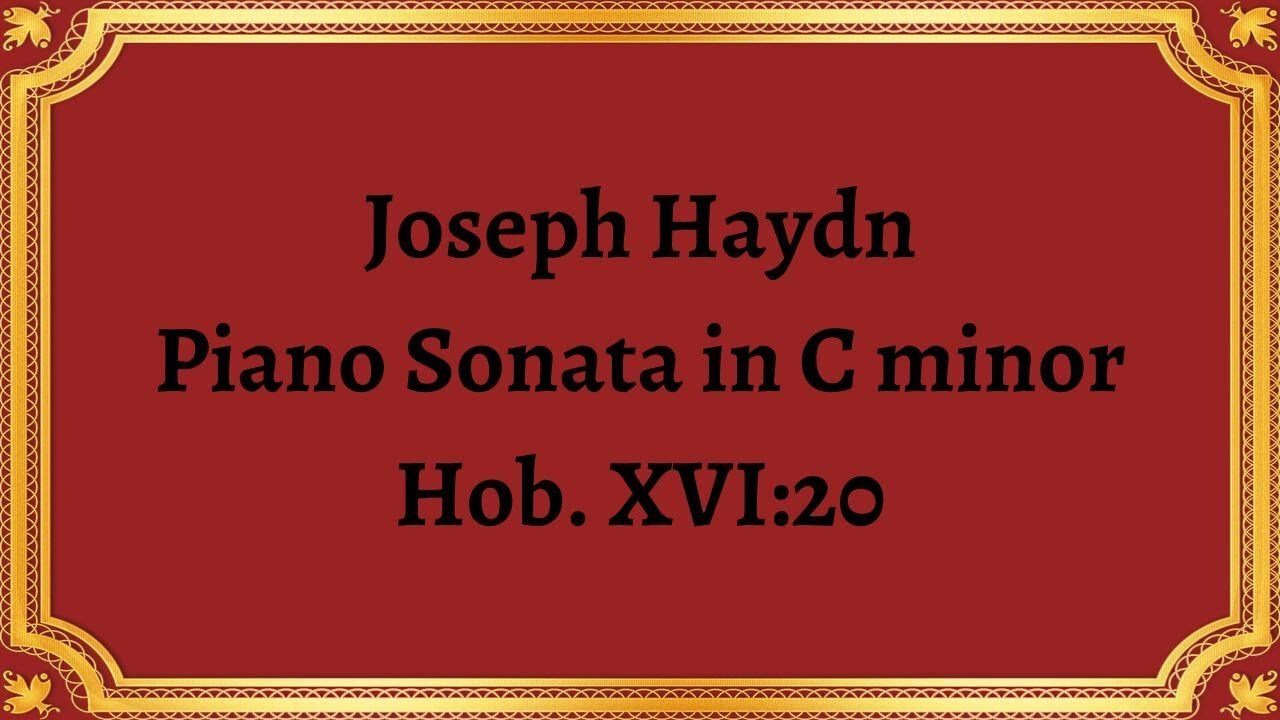Premium Only Content

Joseph Haydn Piano Sonata in C minor, Hob. XVI:20
#JosephHaydn #PianoSonata #Cminor #HobXVI20 #ClassicalMusic #MusicalComposition #RomanticElements #HarmonicComplexity #KeyboardVirtuosity #MusicAnalysis #MusicEducation #PianoRepertoire #KeyboardMusic #MusicHistory.
Joseph Haydn's Piano Sonata in C minor, Hob. XVI:20, written in 1771, is a superb example of the composer's innovative and expressive keyboard writing. The sonata is a shining example of the Romantic elements in classical music and offers a great deal of depth and complexity, making it one of Haydn's most fascinating piano works.
The first movement, marked Moderato, begins with a dramatic and grandiose introduction that immediately engulfs the listener with its dark and foreboding atmosphere. The right-hand melody is accompanied by a persistent pedal tone in the left hand, creating a sense of instability and tension. The movement's main theme is then introduced, featuring a driving rhythm and powerful harmonies that carry throughout the movement.
The second movement, marked Andante con moto, is a beautiful and lyrical contrast to the stormy first movement. The right hand melody is simple and graceful, accompanied by gentle, arpeggiated chords in the left hand. The contrasting section contains expressive melodies and chromatic harmonies before arriving at a peaceful conclusion.
The final movement, marked Allegro, is a lively and energetic conclusion to the sonata. The main theme is a playful and carefree melody that is joyously developed throughout the movement. The intricate counterpoint and melodic interplay between the two hands showcase Haydn's masterful keyboard writing skills.
Haydn's Piano Sonata in C minor, Hob. XVI:20, is a significant work for its time, as it reflects the increasing interest in the individualistic and emotional composition style of the Romantic Era. The Romantic-style harmonies and emotional intensity found in the sonata, anticipate the innovations of the future Romantic composers, particularly Beethoven. The sonata combines traditional sonata form with the idiosyncratic style of Haydn, resulting in an exceptional and powerful composition.
In conclusion, Joseph Haydn's Piano Sonata in C minor, Hob. XVI:20, is an example of the brilliance and innovation of the composer's writing, and his ability to bring together traditional forms with individual expression. The sonata's use of Romantic-era elements, coupled with its beautiful melodies, harmonic complexity, and keyboard virtuosity, makes it a remarkable contribution to the genre of classical music that continues to inspire musicians and music enthusiasts today.
You have the opportunity to support the channel https://destream.net/live/RadSiarAl/donate
-
 12:42
12:42
Cooking with Gruel
17 hours agoBrown Butter Trifle with Salted Caramel and Cinnamon Apple
7591 -
 2:46
2:46
BIG NEM
6 hours agoDiscovering RAKIJA: The Holy Liquer of the Balkans
441 -
 1:11:38
1:11:38
Film Threat
11 hours agoCHRISTMAS DAY CHILL STREAM WITH CHRIS GORE | Hollywood on the Rocks
123K24 -
 14:22:40
14:22:40
The Quartering
1 day agoYule Log Christmas MAGA Edition With Memes! Come Hang Out!
213K29 -
 38:41
38:41
MYLUNCHBREAK CHANNEL PAGE
1 day agoTimeline Begins in 1800? - Pt 1 & 2
94.6K49 -
 1:23:41
1:23:41
Game On!
1 day ago $13.01 earnedNetflix NFL Christmas Games Preview and Predictions!
84.9K13 -
 2:05:07
2:05:07
Darkhorse Podcast
1 day agoWhy Trump Wants Greenland: The 257th Evolutionary Lens with Bret Weinstein and Heather Heying
313K720 -
 8:50:58
8:50:58
Right Side Broadcasting Network
1 day ago🎅 LIVE: Tracking Santa on Christmas Eve 2024 NORAD Santa Tracker 🎅
412K62 -
 2:48
2:48
Steven Crowder
1 day agoCROWDER CLASSICS: What’s This? | Nightmare Before Kwanzaa (Nightmare Before Christmas Parody)
361K13 -
 33:49
33:49
Quite Frankly
1 day agoThe Christmas Eve Midnight Telethon
148K30